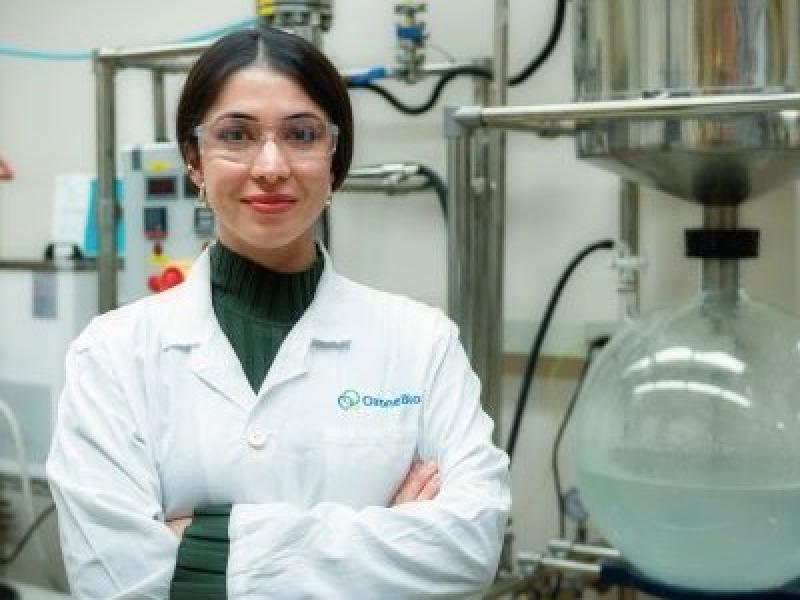
Hydrogen Optimized president and CEO Andrew Stuart (right) and ABB’s division president of process industries Joachim Braun (left) meet at the German-Canadian Atlantic Renewable Hydrogen Expo in Stephenville, Nfld. in August. (Courtesy Hydrogen Optimized Inc.)
Ontario’s Hydrogen Optimized Inc. (HOI) is expanding its strategic relationship with Switzerland’s ABB Ltd., allowing it to further develop and commercialize its RuggedCell water electrolysis technology.
Water electrolysis involves using electricity to separate the hydrogen and oxygen components in water. The scalable RuggedCell technology uses electricity from renewable sources like wind, solar and hydro to turn the water into green hydrogen targeted for industrial, chemical, utility and energy end-users.
Key to the agreement are ABB’s rectifiers, which convert alternating current electricity to direct current.
“To complete our product, we need a rectifier to go with our water electrolyzer . . . without the ability to convert the AC electricity into direct current at hundreds of megawatts at scale, we would not have a full product,” said Andrew Stuart, HOI’s president and CEO. “Secondly, ABB has a vast array of other products and technologies that can provide greater services and value to our clients.
“So we have to take the world’s largest rectification units plus the world’s largest water electrolysis cells, join them together, (and) we can make the world’s largest green hydrogen production systems.”
The partnership between HOI, headquartered in Owen Sound, Ont., and Zurich-based ABB (ABB-N) was born in 2020 via a memorandum of understanding (MOU).
The expanded agreement includes an investment led by ABB’s company’s venture capital unit ABB Technology Ventures into KEY DH Technologies Inc. — HOI’s Collingwood, Ont.-based parent company. Funds will be used to advance HOI’s intellectual property development, prepare for increased business and introduce automated manufacturing and robotics.
Financial terms were not disclosed.
RuggedCell electrolyzer
HOI was formed in 2017 with the “singular focus” of developing the world’s largest water electrolysis cells.
Stuart’s experience in the industry spans from his grandfather — who patented the ‘Stuart cell’ electrolysis system in 1913 — to his son.
In his previous role as president of Stuart Energy, he oversaw the sale of a thousand hydrogen plants in 100 countries. Post-OPEC energy crisis, he saw the large-scale approach to water electrolysis was missing from the equation.
“Today it’s somewhat the same now, we have an energy crisis both in the Ukraine context, but also in the climate change context,” Stuart said. “So energy security is clean energy security.”
In Owen Sound, it has leased a third of the space in a facility — 100,000 square feet, with an option to take up an additional third. That allows the firm to produce about 2 GW of water electrolysis equipment per year.
In April, HOI also signed an MOU with Green Hydrogen International to build an electrolyzer manufacturing facility in Texas, ultimately targeting 5 GW per year production.
Electrolyzers and green hydrogen
As Stuart explained, water electrolysis technology is not new. What has changed is the scale.
HOI’s target market ranges from 500 MW to 2 GW per project, over a decade or longer timeframe. This may be an ammonia plant, for example, or a steel plant switching its production from coal to hydrogen as a fuel.
“It’s our rough estimate that 80 per cent of the investments going into production systems into green hygiene will go into this large-scale segment,” Stuart said. “That’s where we’re centred on, and our goal with ABB is to be a category leader in that very large segment.”
A June report from independent assurance and risk management provider DNV states global electrolyzer capacity will reach an estimated 3,100 GW by 2050, with electricity-based green hydrogen making up 72 per cent of production.
Regarding Canada’s 2050 net-zero goals, Stuart sees hydrogen as making the most impact in industries requiring steel, ammonia and cement production, or in heavy-duty transportation for ships, aircraft or trains.
However, the same report also states the amount of hydrogen in the energy mix will only be five per cent by 2050. To meet the targets of the Paris Agreement, hydrogen uptake would need to triple to meet 15 per cent of energy demand by mid-century.
Stuart said there are numerous countries which could accommodate hydrogen fuel growth at scale, but it will depend upon future industrial needs. At a minimum, however, he plans for plants in “eight or nine” locations globally.
“It’s led by typically one very large client wanting replicating demands for plants, or maybe two or three in one region, say Australia. Then we look at localized manufacturing, where there’s a large growth and this will require water electrolyzer technology,” Stuart explained. “We can camp there to make it locally for one or more clients that are in a region.”










